As of today, Sept. 25, the buyout window is open across the NHL. Already we’ve got some action, courtesy of the Ottawa Senators:
Despite winning the Masterton Trophy this year for his perseverance and dedication to hockey, the Senators could no longer stomach carrying his $7.25 million cap hit. Like their division rivals, the Detroit Red Wings have a couple contracts on their books that aren’t pretty, to say the least.
Related: 7 Red Wings Numbers That Need to Be Retired
Speculation is bound to run rampant as to whether or not the Red Wings will move to rid themselves of these deals. However, a buyout does not completely remove the situation. In fact, we need to establish how buyouts work before we can accurately decide whether or not the Red Wings should exercise a buyout.
A Simplified Guide to Buyouts
The most basic thing to keep in mind when considering a buyout is this: the team executing a buyout will retain a hit to their salary cap for twice the amount of time that was remaining on the deal. For example, if a contract has two years left at the time of a buyout, then the team will carry a cap hit for four years — at a reduced rate of course.
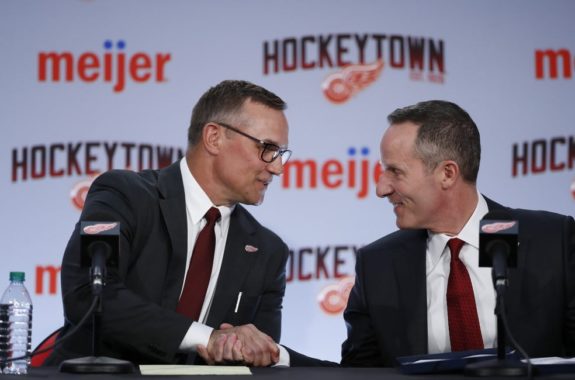
How do you determine what that elongated cap hit will be? If the player is over the age of 26 at the time of the buyout, then the cost of the buyout will be two-thirds of the remaining value on the contract (under the age of 26 costs the team a third of the remaining value.) From there, you spread out that cost evenly over the length of the buyout. You then subtract that cost from the player’s salary. Finally, you subtract that total from the player’s overall cap hit to determine the reduced cap hit.
The team saves money in the front half of the buyout, but experiences a cap loss in the back half. A much more in-depth look at how buyouts work can be found here.
Still with me? Good. With all of this in mind, let’s take a look at the first player the Red Wings could look to buyout: Frans Nielsen.
Farewell, Frans?
In the summer of 2016, the Red Wings acquired some cap space by trading Pavel Datsyuk’s contract. They then used that savings to sign center Frans Nielsen to a six-year deal worth $31.5 million. With a cap hit of $5.25 million, he was signed to hold down the center spot on the team’s second line.
Nielsen provided solid depth scoring in the first three seasons of the deal, but his performance really fell off during the 2019-20 season. He recorded just nine points in 60 games while also averaging 13:41 in ice time — the lowest since he first broke into the league with the New York Islanders. What’s worse is that the defensive game that earned him many Selke votes over the years seemed to disappear entirely.
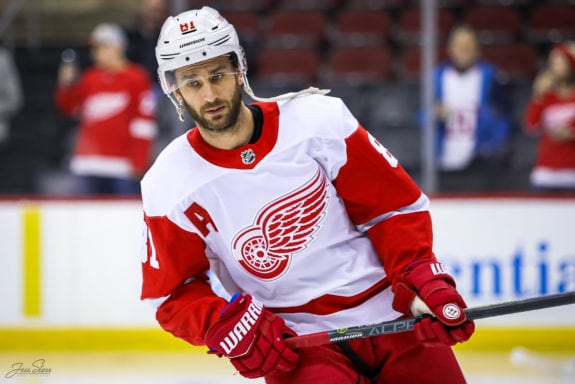
By all accounts, Nielsen is one of those savvy veterans that help in the locker room of a rebuilding team. This is evidenced by the “A” on his sweater. But at what point would the rebuild be better served by inserting a younger face in Nielsen’s place?
If the Red Wings were to exercise a buyout on Nielsen, they would get an immediate salary relief of $1.83 million; the following year, they would get $833,333 in salary relief. With two years left on his deal, the buyout would extend it another two years, with the Red Wings taking on a $666,667 cap-hit in those two years.
Nielsen isn’t the only buyout candidate in Detroit, though. In fact, should the Red Wings exercise a buyout, this next candidate is hands-down the crowd favorite.
Adiós, Abdelkader?
In Nov. 2015, winger Justin Abdelkader signed a seven-year extension worth $29.75 million. While a $4.25 million cap hit on its own isn’t that restrictive, it’s his lack of production that makes this contract such an eyesore for fans.
Since the extension kicked in, Abdelkader has recorded 78 points in 259 games — including just three points in 49 games this season. His average ice time of 11:32 this season was the lowest since his first full season in the NHL, the 2009-10 campaign. He’s a player that is meant to bring intensity to the Red Wings’ lineup while also providing an example for the team’s younger players (he also wears an “A” on his jersey.)
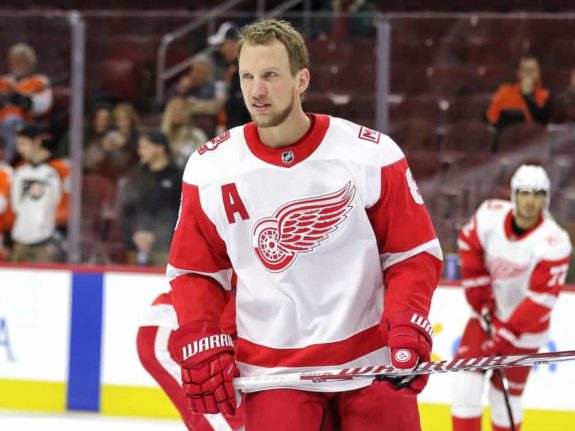
There are three years left on Abdelkader’s deal; he and Dylan Larkin are the only players the team has signed past the 2021-22 season. If the Red Wings were to buy Abdelkader out, they would carry his contract on the books for another six(!) years. In the additional years, the Red Wings would carry a cap hit of a little over $1 million.
Current Cap Situation
The Red Wings have cap space this offseason — almost $35 million before re-signing guys like Anthony Mantha and Tyler Bertuzzi. Once that business is taken care of — and the team figures out their goalie situation — they should still have plenty of financial flexibility. A closer look at the Red Wings’ salary situation can be found here.
Following the 2020-21 season, the Red Wings are poised to receive an additional $23.3 million in cap space. Essentially, their salary-cap situation is finally healing, and it looks like it’s only going to get better. So, if the Red Wings aren’t hurting for cap space, why would they pull the trigger on a buyout?
Long-Term View
Let’s get this out of the way right now: the Red Wings should not use a buyout on Abdelkader. Keeping that contract on the books for an additional three years should make any fan sick to their stomach, and the $1 million penalty for doing so could actually come back to bite the organization.
How so? Well, by the time the Red Wings start getting hit by that penalty, they should hopefully be on their way up from the basement. All of their top prospects will be off of their entry-level deals, meaning they’re going to get paid real money. The Red Wings will also have to give a raise to Larkin, while also paying any free agents they may have signed between now and then.
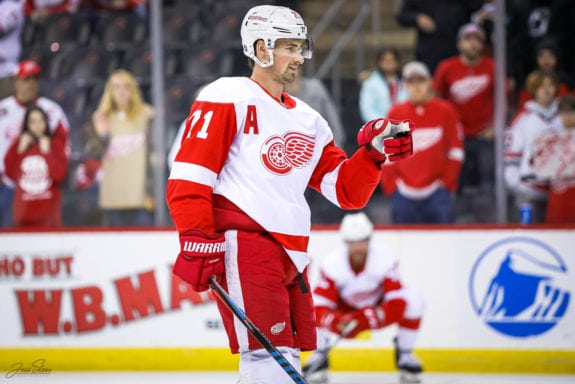
While $1 million isn’t a ton in terms of the salary cap, it could very well be the difference between keeping a player or seeing them leave for greener pastures. This Abdelkader contract has done enough damage; the Red Wings shouldn’t give it the chance to do any more harm.
Unclogging the Roster
That being said, there is an argument to be made for buying out Nielsen. Extending his deal from two year to four doesn’t sound that great until you realize the Red Wings will only get hit with a $666,667 strike against their cap during those extra two years — that’s less than the minimum salary for an NHL player. But the real argument for buying him out isn’t about money, it’s about creating opportunity.
Perhaps the biggest benefactor of a potential Nielsen buyout is the Red Wings’ top pick in the 2017 draft, Michael Rasmussen. Despite the latter being drafted as a center, he hasn’t been able to gather experience at the position in the NHL because the Red Wings have an abundance of centers on their roster already, including Nielsen.
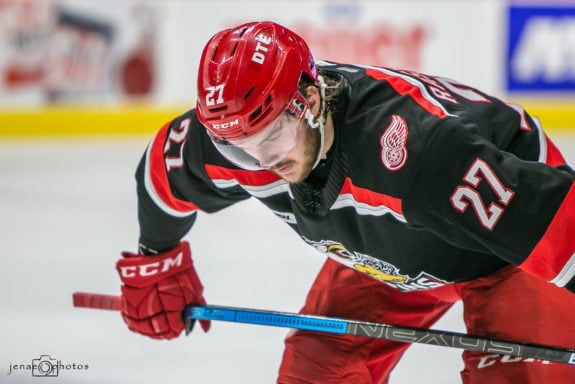
A buyout would not only create an opportunity for Rasmussen, but 2018 first-round pick Joe Veleno as well. Both are natural centers, though both can play on the wing as well. If the Red Wings are looking to establish their center group of the future, it would behoove them to give their top center prospects the opportunity to play sooner rather than later. Rasmussen, in particular, could really use the NHL reps.
Make It Make Sense
The Red Wings have not utilized a buyout since they parted ways with defenseman Xavier Ouellet in the summer of 2018. Before that, the team bought out center Stephen Weiss and they still have a $1.67 million cap penalty because of it. The last time Weiss played for the Red Wings was the spring of 2015.
Buyouts are useful if they’re used under the right circumstances. Removing “dead weight” off of the roster is a good reason, but the cost needs to make sense. In some cases, the cure can do more damage than the disease.
Related: Remembering Mr. Hockey Gordie Howe
Now that the Red Wings’ cap situation isn’t as bleak, they can afford to wait out their worst contracts. That’s why they don’t need to exercise a buyout. However, they also need to ensure that opportunity and roster spots are available for those that deserve them. General manager Steve Yzerman is known for making bold decisions; this year’s buyout window could very well show how he earned that reputation.